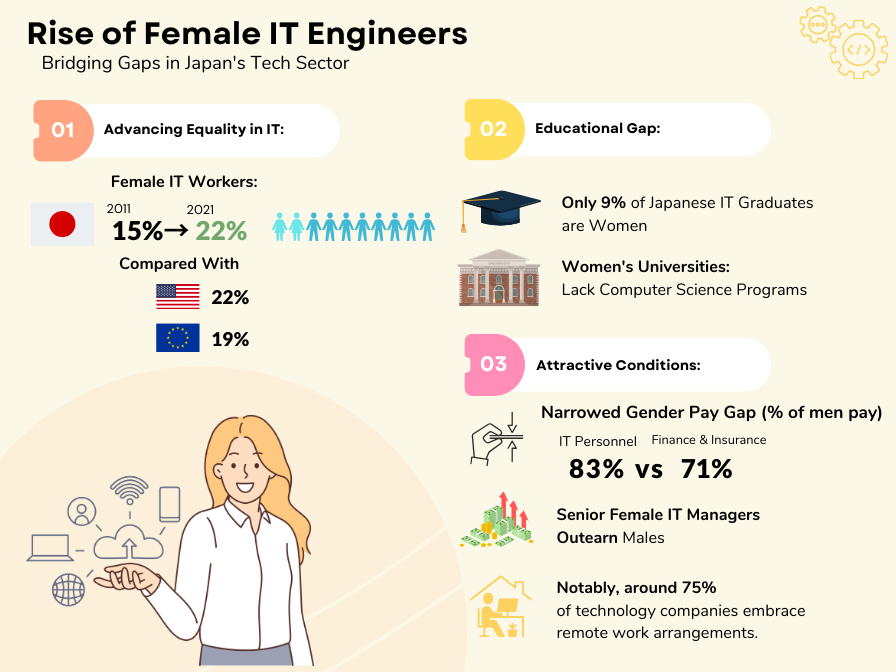Female IT Engineers to the Rescue?

Two fields in which Japan is seen as behind the curve are workplace equality and the IT sector as a whole. Against such a backdrop, a sharp rise in the number of female software engineers in Japan seems an unlikely phenomenon. And yet that is exactly what has been happening in recent years. Issues such as a dearth of women graduating in computer science remain, but the need for female IT specialists will only continue to grow. Meanwhile, the better pay and terms they are able to command should help drive an improvement in conditions for all in the sector.
Despite its excellent showing in the education and health criterion, each year Japan slips a few more places down the rankings in the World Economic Forum’s Global Gender Gap Report. This year’s showed it had dropped to 125th out of 146 countries, again due to inequalities in the political and economic spheres (particularly the former). Female workforce participation is improving in Japan, but not as quickly as it is in other nations, especially many of the emerging countries that surround it near the lower end of the rankings.
Similarly, Japan slipped to its worst 29th place out of 63 economies in the IMD World Digital Competitiveness Ranking last year. But IT is one sector where some promising progress is being made in gender equality.
Levelling the playing field
Women made up 15% of IT workers in 2011; a number that had risen to 22% by 2021, according to the Japan Information Technology Services Industry Association. At first glance, that may still appear quite low, but in a field that remains male-dominated globally, it is on a par with the United States (22% and down slightly over the same period) and a couple of points ahead of the EU average (19% and up slightly).
Better pay and conditions are helping attract more women into the sector. A smaller gender pay gap sees female IT personnel paid 83% of male counterparts, compared to 71% in finance and insurance, according to a study by the Ministry of Health, Labour and Welfare. Senior female managers in IT actually outearn male ones. In addition, around three-quarters of technology firms currently allow remote work, a higher proportion than any other industry and a potential deal breaker for women continuing their careers in parallel with child rearing.
As labour shortages intensify with the declining population, the demand in growth sectors like IT for qualified workers irrespective of gender will expand in parallel, improving conditions for all. An increasing number of firms are already offering more flexible working styles and structures to attract the necessary talent, with some applicants now negotiating terms before accepting positions – an approach that would have seemed unthinkably impertinent in corporate Japan a decade ago.
Broader perspectives and fundamental knowledge
The growth in female IT engineers has so far been driven almost entirely by people switching careers from other fields, following retraining or self-study to acquire the requisite skills. Only 9% of those graduating from Japanese universities with IT-related degrees are women, compared to around double that figure in the UK, France and US, and triple it in South Korea (although ahead of Japan, also a gender equality underperformer).
Some women’s universities in Japan don’t offer computer science degrees at all – low-hanging fruit in terms of potential changes that could be made. Coming from other fields can bring valuable outside perspectives, but can also lead to a lack of the kind of foundational knowledge acquired during academic study. This is not an issue peculiar to female IT personnel, many companies in Japan train general staff to work in the field as part of job rotation systems.
Policy measures at the national level to boost the number of female engineers produced by the education system would help alleviate the skill shortage in the sector, while on a personal level, more senior female IT specialists mentoring new entrants would increase the odds of them enjoying longer and more productive careers.
Japan’s government is predicting a shortfall of hundreds of thousands of IT specialists in the years ahead, resulting in trillions of yen of potential economic activity lost. More female IT engineers, whether mid-career switches or new graduates, can play a major role in easing those shortcomings and keeping the Japanese economy moving.
By: Gavin Blair
We are currently looking for these roles:
1.Field Service Technician
2.Insurance Practice Solutions Head
3.Infra Engineer
4.Data Architect
5.Application Architect
6.Sr. Business Analyst / Lead Consultant
7.Radar Systems Engineer – Bilingual
8.Automotive Validation Engineer – Bilingual
9.ADAS Algorithm Engineer – Bilingual
10.Learning Program Manager
To find out more about hot roles in sustainability area and elsewhere please contact us at +81-3-5962-5888 or email us at info@slate.co.jp

